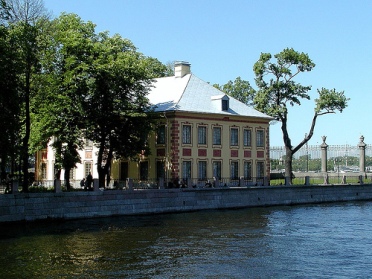

Kutuzov Naberezhnaya 2
Tel. 314- 0374
Closed: Tues Jan- April
Summer Palace is a Baroque royal residence constructed in the early 18th century for Russian Emperor Peter I about the same time Saint Petersburg was established. Summer Palace is located on the banks of Neva river surrounded by a Summer Garden. Summer Palace with its 14 rooms was intended as a private residence during summer months, rather than hold any state events.
The Summer Palace was built in the Petrine Baroque style according to
the design of Domenico Trezzini in 1710-1714. This is one of the oldest
buildings in the city. The two-storey palace consists of fourteen rooms
and two kitchens. The residence was intended for use only in the warm
season - from May to October, so the walls in it are quite thin, and the
windows have single frames.
Almost square in plan, the building
with a hip roof in the European style and a weather vane at the top
resembles the Mauritshuis Palace in The Hague. The tinned iron roofs
were painted gray to look like slate, which is used to cover buildings
in the Nordic countries. The construction was led by A. Schluter with
assistants: I.F. Braunstein and others. 29 terracotta reliefs on the
facades of the palace represent allegories of the events of the Northern
War (made from engravings by the German artist A. Fuchs, repeating the
Italian originals by A. Majoli of the late 16th century in a mirror
image). The relief above the entrance was created by the sculptor
Morberg based on a drawing by G. I. Mattarnovi. The interiors of the
Summer Palace, like many other palaces of the Petrine era, were designed
according to projects that J.-B. A. Leblon, and according to the
drawings of his assistant N. Pino. These projects used lambri - wooden
panels to the full height of the walls with stucco, painted in light
colors and partial gilding, as well as murals, mirrors, fireplaces and
desudesports, padugas, picturesque ceiling lamps. Separate paintings
were made by Russian masters A. Zakharov, I. Zavarzin and F. Matveev.
Peter moved into the partially finished palace in 1712 and lived
there every summer until his death (1725). He occupied the lower floor,
and the premises of the second floor were intended for Catherine. After
the death of Peter until the middle of the 19th century, the palace was
used as a summer residence for dignitaries and courtiers: A. I.
Gorchakov (in 1815), D. I. Lobanov-Rostovsky (in 1816), M. A.
Miloradovich (since 1822) , E. F. Kankrin (1830s), F. P. Vronchenko
(1840s). The dignitaries lived here during the cold season; they were
given only the second floor. Under Alexander I, in spring and summer,
the public began to be allowed into the royal residence; in 1840, a
detailed inventory of "historical monuments" was compiled, some of them
were restored.
In 1934, a historical and household museum was
opened in the palace building. During the Great Patriotic War, the
building was damaged: the frames were torn out, the plaster on the
ceilings of the rooms and on the facade crumbled, the roof was damaged
by shell fragments. The restoration of the palace began in 1946. In 1947
the museum was reopened to the public. In the 1950s and 1960s, a
full-scale restoration was carried out in order to restore the original
appearance of the palace, including the floors were replaced, the
heating system was changed, modeling was restored, the ceiling pattern
was restored, and the upholstery of the walls with fabric was returned.